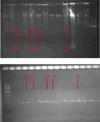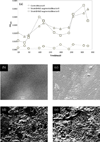Isolation and molecular identification of landfill bacteria capable of growing on di-(2-ethylhexyl) phthalate and deteriorating PVC materials
- PMID: 22934997
- PMCID: PMC3432978
- DOI: 10.1080/10934529.2012.707549
Isolation and molecular identification of landfill bacteria capable of growing on di-(2-ethylhexyl) phthalate and deteriorating PVC materials
Abstract
Waste materials containing Di-(2-ethylhexyl) phthalate (DEHP), a suspected endocrine disruptor and reasonably anticipated human carcinogen, are typically disposed of in landfills. Despite this, very few studies had been conducted to isolate and identify DEHP-degrading bacteria in landfill leachate. Therefore, this study was conducted to isolate and characterize bacteria in landfill leachate growing on DEHP as the sole carbon source and deteriorating PVC materials. Four strains LHM1, LHM2, LHM3 and LHM4, not previously reported as DEHP-degraders, were identified via 16S rRNA gene sequence. Gram-positive strains LHM1 and LHM2 had a greater than 97% similarity with Chryseomicrobium imtechense MW 10(T) and Lysinibacillus fusiformis NBRC 15717(T), respectively. Gram-negative strains LHM3 and LHM4 were related to Acinetobacter calcoaceticus DSM 30006(T) (90.7% similarity) and Stenotrophomonas pavanii ICB 89(T) (96.0% similarity), respectively. Phylogenetic analysis also corroborated these similarities of strains LHM1 and LHM2 to the corresponding bacteria species. Strains LHM2 and LHM4 grew faster than strains LHM1 and LHM3 in the enrichment where DEHP was the sole carbon source. When augmented to the reactors with PVC shower curtains containing DEHP, strains LHM1 and LHM2 developed greater optical densities in the solution phase and thicker biofilm on the surfaces of the shower curtains.
Figures






Similar articles
-
PVC biodeterioration and DEHP leaching by DEHP-degrading bacteria.Int Biodeterior Biodegradation. 2012 Apr 1;69:73-81. doi: 10.1016/j.ibiod.2011.12.011. Epub 2012 Feb 15. Int Biodeterior Biodegradation. 2012. PMID: 22736894 Free PMC article.
-
Microbial treatment of bis (2-ethylhexyl) phthalate in polyvinyl chloride with isolated bacteria.J Biosci Bioeng. 2005 Feb;99(2):115-9. doi: 10.1263/jbb.99.115. J Biosci Bioeng. 2005. PMID: 16233766
-
Biodegradation of an endocrine-disrupting chemical, di-2-ethylhexyl phthalate, by Bacillus subtilis No. 66.Appl Microbiol Biotechnol. 2005 Mar;66(6):702-10. doi: 10.1007/s00253-004-1683-6. Epub 2004 Oct 23. Appl Microbiol Biotechnol. 2005. PMID: 15517247
-
Progress in the removal of di-[2-ethylhexyl]-phthalate as plasticizer in blood bags.Transfus Med Rev. 2012 Jan;26(1):27-37. doi: 10.1016/j.tmrv.2011.06.001. Epub 2011 Aug 5. Transfus Med Rev. 2012. PMID: 21820855 Review.
-
Materials degradation in PVC medical devices, DEHP leaching and neonatal outcomes.Curr Med Chem. 2010;17(26):2979-89. doi: 10.2174/092986710792064992. Curr Med Chem. 2010. PMID: 20858177 Review.
Cited by
-
Enrichment of native plastic-associated biofilm communities to enhance polyester degrading activity.Environ Microbiol. 2023 Dec;25(12):2698-2718. doi: 10.1111/1462-2920.16466. Epub 2023 Jul 28. Environ Microbiol. 2023. PMID: 37515381 Free PMC article.
-
Lessons From Insect Fungiculture: From Microbial Ecology to Plastics Degradation.Front Microbiol. 2022 May 24;13:812143. doi: 10.3389/fmicb.2022.812143. eCollection 2022. Front Microbiol. 2022. PMID: 35685924 Free PMC article.
-
Enriched microbial consortia from natural environments reveal core groups of microbial taxa able to degrade terephthalate and terphthalamide.PLoS One. 2024 Dec 27;19(12):e0315432. doi: 10.1371/journal.pone.0315432. eCollection 2024. PLoS One. 2024. PMID: 39729501 Free PMC article.
-
Microbial Degradation and Valorization of Plastic Wastes.Front Microbiol. 2020 Apr 21;11:442. doi: 10.3389/fmicb.2020.00442. eCollection 2020. Front Microbiol. 2020. PMID: 32373075 Free PMC article. Review.
References
-
- Staples CA, Peterson DR, Parkerton TF, Adams WJ. The environmental fate of phthalate esters: A literature review. Chemosphere. 1997;35:667–749.
-
- Patil NK, Veeranagouda V, Vijaykumar M, Nayak SA, Karegoudar T. Enhanced and potential degradation of o-phthalate by Bacillus sp. immobilized cells in alginate and polyurethane. Int. Biodeter. Biodegr. 2006;57:82–87.
-
- Shelton DR, Boyd SA, Tiedje AM. Anaerobic biodegradation of phthalic acid esters in sludge. Environ. Sci. Technol. 1984;1904:93–97. - PubMed
-
- Chao W, Cheng C. Effect of introduced phthalate-degrading bacteria on the diversity of indigenous bacterial communities during di-(2-ethylhexyl) phthalate (DEHP) degradation in a soil microcosm. Chemosphere. 2007;67:482–488. - PubMed
-
- Oliver R, May E, Williams J. Microcosm investigation of phthalate behavior in sewage treatment biofilms. Sci. Total Environ. 2007;372:605–614. - PubMed
Publication types
MeSH terms
Substances
Grants and funding
LinkOut - more resources
Full Text Sources
Molecular Biology Databases
